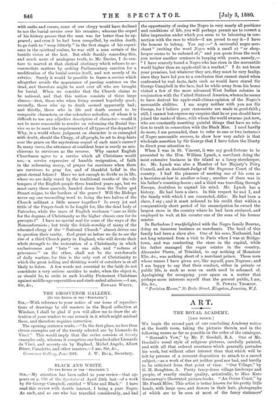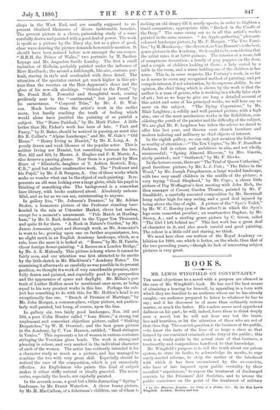ART.
[LAST NOTICE.]
WE begin the second part of our concluding Academy notice- at the fourth room, taking the pictures therein and in the following rooms as far as possible in the order of the catalogue.
"Hannah's Vow," by Mr. F. Goodall, R.A. One of Mr. Goodall's usual style of religious pictures, carefully painted, and with all that ordered sweetness which generally pervades his work, but without other interest than that which will be felt by persons of a reverent disposition to attach to a sacred subject,—as a work of fine art neither good nor bad, and hardly to be criticised from that point of view. "Our Village," by G. H. Boughton, A. Pretty fancy-dress village landscape and people, of exactly similar quality, artistically, to Miss Kate Greenaway's illustrated picture-books. "An Ocean Coast," by Mr. Frank Miles. This artist is better known for his pretty little heads, with large eyes, and flowers in their hair, photographs of which are to be seen at most of the fancy stationers'
shops in the West End, and are usually supposed to re- present idealised likenesses of divers fashionable beauties. The present picture is a clever, painstaking study of a wave carefully drawn and painted with a good deal of power. The work is spoilt as a picture by the lilacy sky, but as a piece of good, clear wave-drawing the picture demands honourable mention. It should have been noticed before now amongst the sea-scapes. " H.R.H. the Prince of Wales," two portraits by M. Bastian Lepage and Mr. Augustus Savile Lumley. The first a small imitation of Holbein, probably painted under the influence of Herr Kaulbach ; the second a full-length, life-size, costume por- trait, staring in style and overloaded with dress detail. The attention of the spectator cannot get much higher in this pic- ture than the rosettes on the Heir Apparent's shoes and the gloss of his new silk stockings. "Ordered to the Front," by Mr. Prank Roll. Powerful and thoughtful work, coming perilously near to the "sentimental," but just saved by its earnestness. " Corporal Trim," by Mr. J. D. Wat- son. Much better than the artist's work in the earlier room, but hardly reaching the truth of feeling which would alone have justified the painting of so painful a subject. The "Home Paddock," by Mr. Mark Fisher. A little better than Mr. Fisher's work has been of late. "Fact and Fancy," by D. Bates, should be noticed in passing, as must also ;Sir R. Collier's "Alpine Landscape," and Mr. W. Gale's "Old Home." "Henry Irving as Hamlet," by Mr. E. Long, A. A poorly drawn and weak likeness of the popular actor. This is neither Irving nor Hamlet, but something between the two. Nos. 422 and 424, by Messrs. A. Hughes and P. R. Morris, A., also deserve a passing glance. Near them is a portrait by Miss Starr of "Elizabeth, daughter of T. Ashton Bostock, Esq., C.B.," good but rather unattractive work. The "Professor and his Pupil," by Mr. J. B. Burgess, A. One of those works which make us wonder what can be the object of such painting. It re- presents an old man looking over a large globe, while his pupil is thinking of something else. The background is a somewhat bare library, with books scattered about. Absolutely unbeau- tiful, and as far as we can see, uninteresting to anyone.
In gallery five, "Dr. Johnson's Penance," by Mr. Adrian Stokes, a humorous picture of the Professor standing bare- headed in the rain at Uttoxeter Market, clever but useless, -except for a moment's amusement. "Polo Match at Hurling- ham," by Mr. G. Earl, dedicated to the Upper Ten Thousand, and quite fit for them. "A Nook in Nature's Garden," by Mr. James Aumonier, quiet and thorough work, as Mr. Aumonier's is wont to be ; growing upon one on further acquaintance, too, no slight merit in an English Academy landscape, which, as a rule, loses the more it is looked at. "Roses," by Mr. H. Fantin, -clever foreign flower-painting. "A Recess on a London Bridge," by Mr. A. E. llulreally. This picture is hung where it cannot be fairly seen, and our attention was first attracted to its merits by the little sketch in Mr. Blackburn's "Academy Notes." On -examining it afterwards as carefully as was possible in its present position, we thought it a work of very considerable promise, care- fully drawn and painted, and especially good in its perspective and the appearance of space and daylight. Mr. Millais's por- trait of Luther Holden must be mentioned once more, as being -equal to his very greatest works in this line. Perhaps the sub- ject has something to do with this, for Mr. Holden's head is an exceptionally fine one. "Breach of Promise of Marriage," by Mr. John Morgan, a common-place, vulgar picture, not particu- larly well painted, but hung, of course, upon the line.
In gallery six, two fairly good landscapes, Nos. 562 and 584, a poor Cohn Hunter called "Iona Shore ;" a strong but unpleasant and somewhat objectless picture, called "Sinking Despatches," by W. H. Overend ; and the best genre picture in the Academy, by C. Van Haanen, entitled, "Bead-stringers in Venice." This represents a lot of women in various costumes stringing the Venetian glass beads. The work is strong and pleasing in colour, and very marked in the individual character of each of the women. The artist has evidently intended it for a character study as much as a picture, and has managed to combine the two with very great skill. Especially should be noticed the ease of the composition, which is yet excessively effective. An Englishman who paints this kind of subject makes it either stiffly natural or ideally graceful. The acces- sories, especially the heads, are capitally painted.
In the seventh room, a good but a little distracting" Spring" landscape, by Mr. Ernest Waterlow. A clever funny picture, by Mr. H. MacCallum, of a fisherman's children, one of whom is rocking an old dingey till it nearly upsets, in order to frighten a timid companion ; appropriate title, "Rocked in the Cradle of the Deep." The same sunny sea as in all this artist's works, painted in the same manner. "Au Apple-gathering," pleasant- coloured landscape picture, by Mr. F. Morgan. "The Two Fami- lies," by M. Munkacsy,—the cleverest, as Van Haanen's is the best, genre picture in the Academy. So it ought to be, considering that the artist rates it at 3,000 guineas. The interior of a room, full of sumptuous decoration ; a family of pug puppies on the floor, and a couple of children looking at them ; a lady seated by a table in the room, and a nurse holding one of the children in her arms. This is, in some respects, like Fortuny's work, in so far as it seems to scorn any recognised method of painting, and yet compels interest, if not admiration, by its supreme ability. In our opinion, the chief thing which is shown by the work is that the author is a man of genius, who is working in a wholly false style of art ; but as we hope to give ere long a detailed account of this artist and some of his principal works, we will here say no more on the subject. "The Dying Copernicus," by Mr. Blair Leighton ; a solidly and well painted picture, with a high aim ; one of the most meritorious works in the Exhibition, con- sidering the youth of the painter and the difficulty of the subject. We are glad Mr. B. Leighton has taken the advice we dared to offer him last year, and thrown over church furniture and modern tailoring and millinery as chief objects of interest.
In the eighth gallery, we can only just mention the following as worthy of attention :—" The Ten Virgins," by Mr. F. Hamilton Jackson, full in colour and ambitious in aim, and not wholly unsuccessful ; "Spring Almond Blossom," by Mrs. Guerin, nicely painted ; and "Outlawed," by Mr. F. Stocks.
In the lecture-room, there are" The Trial of Queen Catherine," good furniture picture, by Mr. L. J. Pott ; "The Babes in the Wood," by Mr. Joseph Farquharson, a large wooded landscape, with two very small children in the middle of the picture ; a very trying "Good Shepherd," by Mr. Cope ; a clever little picture of Peg Woffington's first meeting with John Rich, the then manager of Covent Garden Theatre, painted by Mr. F Smallfield; a carefully executed composition by Mr. Brewtnall hung rather high for easy seeing, and a good deal injured by being above the line of sight. A picture of the" Syce's Toilet," by Mr. W. C. Horsley (son of the artist ?) in which the Syce's legs seem somewhat peculiar ; an unattractive Daphne, by Mr. Storey, A.; and a sterling genre picture by C. Green, called "The Girl I left behind me." This last work has a great deal of character in it, and also much careful and good painting. The colour is a little cold and staring, we think.
We must here close our notices of the Royal Academy ex- hibition for 1880, one which is better, on the whole, than that of the two preceding years,—though its lack of interesting subject pictures is very great.



































 Previous page
Previous page